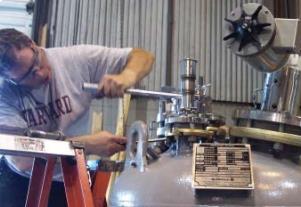 We talked last week about the criteria for designing efficient cleaning systems in filter/dryers and the various options available. To reiterate a bit on the history and definition of “in-place” cleaning, this term identifies the ability to clean without dismantling the equipment. Cleaning systems vary for different types of equipment and the solution can differ based on factors such as equipment material of construction, soil load, and vessel geometry. One aspect remains consistent, though – all in-place cleaning systems aim to deliver good, effective cleaning. Regardless of the level of cleaning required (WIP, CIP, or SIP), cleaning in-place equates to faster, easier cleaning, less labor required to achieve cleaning, and a reduced risk of chemical exposure to employees.
We talked last week about the criteria for designing efficient cleaning systems in filter/dryers and the various options available. To reiterate a bit on the history and definition of “in-place” cleaning, this term identifies the ability to clean without dismantling the equipment. Cleaning systems vary for different types of equipment and the solution can differ based on factors such as equipment material of construction, soil load, and vessel geometry. One aspect remains consistent, though – all in-place cleaning systems aim to deliver good, effective cleaning. Regardless of the level of cleaning required (WIP, CIP, or SIP), cleaning in-place equates to faster, easier cleaning, less labor required to achieve cleaning, and a reduced risk of chemical exposure to employees.
This automated process is accomplished through the use of spray systems, tank cleaners, nozzles and other peripherals that access all the areas that need to be cleaned (along with further enhancements like temperature elevation and chemical detergents that can be incorporated to facilitate cleaning). To read up on the basics of cleaning in-place and the difference between WIP (wash-in-place), CIP (clean-in-place) and SIP (sterilize-in-place) see last week’s post.
With regards to glass-lined vessels, there are a unique set of challenges to overcome. De Dietrich Process Systems has knowledge and experience in providing wash-in-place solutions for its reactors and tanks.
Note: Some companies’ primary expertise and entire business offering lies in CIP and WIP systems and components. De Dietrich Process Systems is not implying such extensive knowledge, but we do have thorough experience in knowing the challenges specific to our equipment and are competent at providing wash-in-place solutions for our product line.
Cleaning Challenges for Glass-Lined Vessels
Designing wash-in-place systems for glass-lined equipment presents a variety of difficulties, mainly due to the internal vessel geometries and the limited number of vessel openings for cleaning wands/lances. Furthermore, the issue can be complicated by the exotic materials of construction that are sometimes required when working with special products and chemicals. In addition, every reactor can have subtle differences which can alter the design of the CIP system.
An effective cleaning system for glass-lined vessels must take the following factors into account:
- Number of spray balls
- Type of spray balls
- Spray ball orientation
- Spray ball material of construction (stainless steel or Hastelloy)
- Selected spray ball pressure, flow, and cleaning time
- Vessel material of construction (glass-lined or Hastelloy)
- Type of vessel (close-welded, clamped-top)
- Size of vessel
- Nozzle openings used for spray ball placement
DDPS Solutions for Glass-Lined Vessels
There are many fixed and variable parameters that have an impact on the cleaning process, such as chemical factors (product/solvent), temperature, vessel material, equipment design, mechanical impact, and cleaning time (these elements that come into consideration when designing a cleaning system were discussed in greater detail last week). Once these factors are determined a customized solution can be devised that provides optimal cleaning for your new or existing equipment. For very small volume reactors, cleaning can be achieved simply by filling the vessel with cleaning solution, waiting a period of time (during which the agitator can be employed), and draining it. However, on larger vessels the “soak method” is too timely and expensive. Therefore on agitated vessels, De Dietrich Process Systems typically recommends two spray nozzles on 200 gallon and smaller vessels and three spray nozzles on 300 through 4000 gallon vessels for the most effective cleaning. Each process can prove to be unique from the next, though, so that is more or less a generalization. Additional details like spray ball placement, size and orientation need to be determined as well.
From there the design is completed and installed into your system followed by a riboflavin fluorescence test that is performed in our factory to assure the coverage is adequate and identify any blind spots in the cleaning system. Based on the results of this initial test, the system can be modified, if needed, to fully achieve the required performance objectives. Some tweaks that can be performed to solve problem areas include adding a spray ball, changing the angle of the spray ball or adding an additional hole into a ball to allow cleaning solution to penetrate a hard to reach areas. Once the test is repeated, any other problem areas (e.g. a gasketed surface or dead zone in a nozzle) are thoroughly documented and the addressed areas can be handled with manual cleaning. The riboflavin test is then repeated and the results are documented and certified (because validation is always reassuring when you are dealing with something as important as WIP, right?). In addition to testing performed prior to shipment, DDPS can repeat the test in the field after installation.
For most applications DDPS can guarantee at least 98% coverage of the reactor. By utilizing the OptiMix reactor design, we can improve the cleaning to an even higher efficiency. OptiMix incorporates three baffles onto the vessel wall, thereby eliminating the dead space that is created around the top of traditional baffles. If you are working with a limited number of nozzle openings, this design enables nozzles to be available for cleaning system purposes rather than baffle installations. (For more information about OptiMix technology check out this post on baffle options for glass-lined reactors).
Wash-in-place technology is definitely worth the investment to help save time, optimize your vessel’s performance, and establish a repetitive cleaning cycle for continual efficiency in cleaning. DDPS can design and test systems to clean new and existing reactors and tanks as well as associated ancillary equipment, including heat exchangers and piping systems. Contact us so we can discuss your cleaning needs and develop a solution for your equipment.
